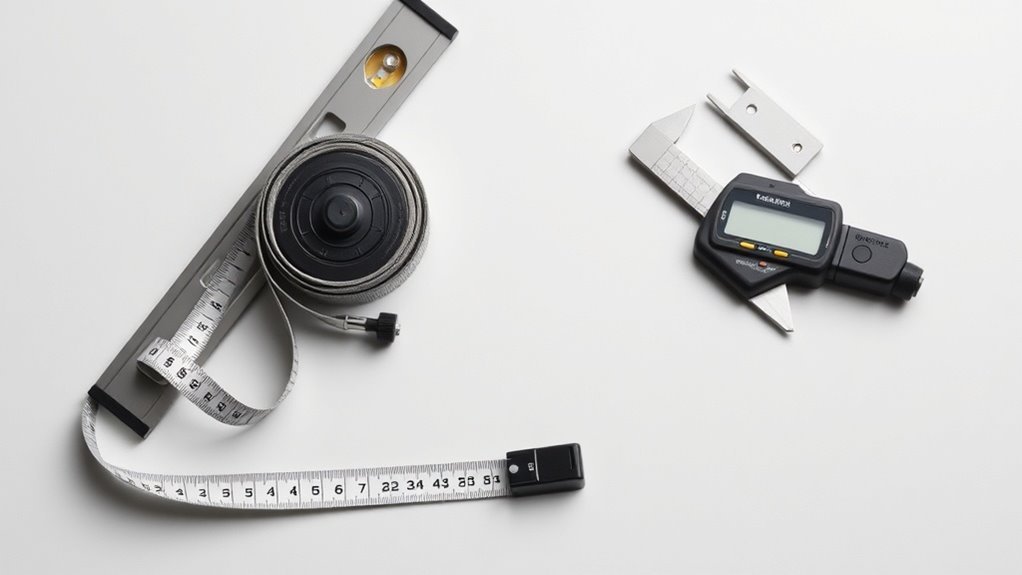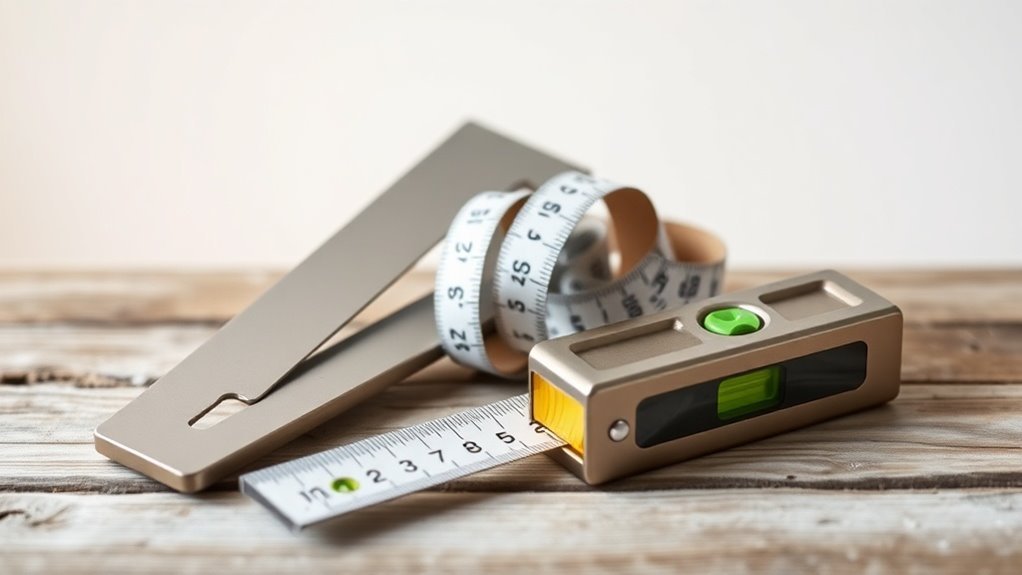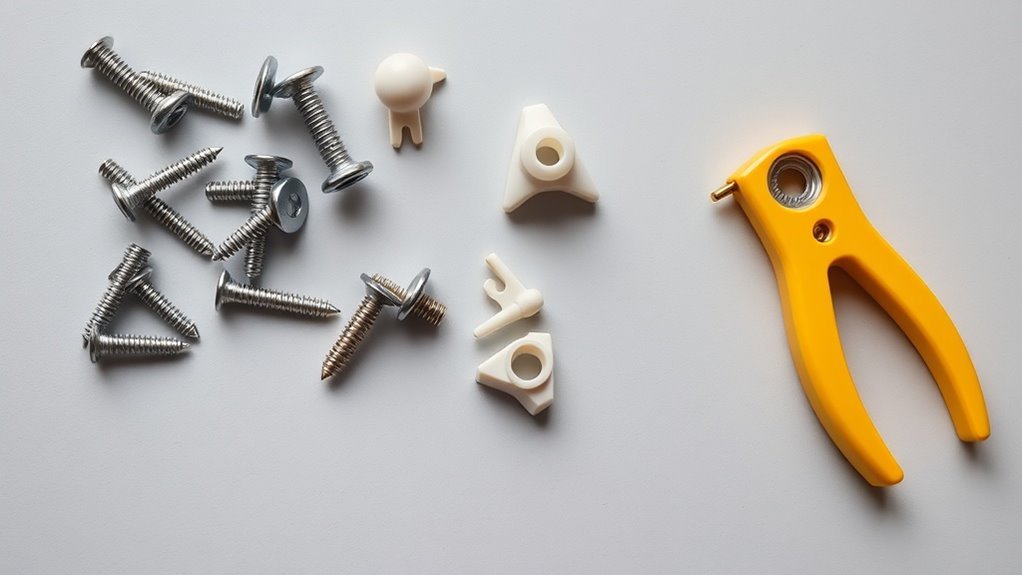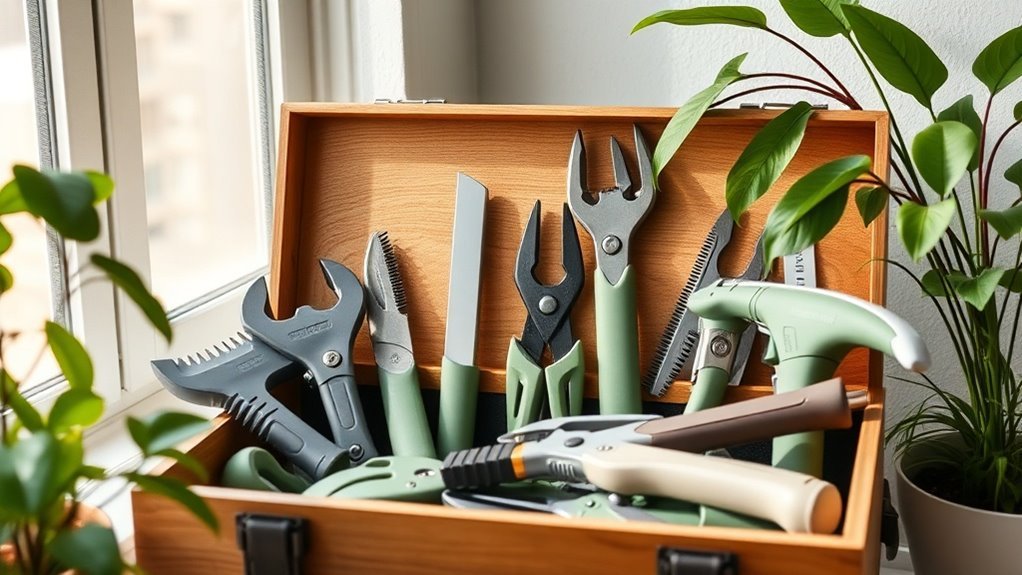The Role of Measuring Tools in Home Renovations

Measuring tools play a crucial role in home renovations. They help guarantee every element fits perfectly, saving you from costly mistakes and fitting issues. Tools like tape measures and laser levels provide precision for accurate dimensions and alignments. By double-checking your measurements, you can avoid errors that lead to wasted materials and time. Keep your tools calibrated, and you’ll see significant improvements in your project’s outcome. Discover more about essential tools for a successful renovation journey.
Key Takeaways
- Accurate measurements are crucial in renovations, preventing costly mistakes and ensuring materials fit correctly.
- Essential measuring tools like tape measures and levels help maintain precision during design and construction.
- Laser levels improve alignment over long distances, minimizing guesswork and enhancing professional results in projects.
- Double-checking measurements and using quality tools can significantly reduce errors and improve overall craftsmanship.
- Properly utilizing measuring tools maximizes space and functionality, aligning with the renovation’s intended design vision.
The Importance of Accurate Measurements
When it comes to home renovations, if you don’t prioritize accurate measurements, you’re setting yourself up for frustration and potential costly mistakes. Inaccurate dimensions can lead to fitting issues, wasted materials, and more significantly, a substantial hit to your budget.
For instance, if you miscalculate the space for cabinets or furniture, you might end up with items that don’t fit, forcing you to either return them or make inconvenient changes. This can delay your project and amplify stress.
Furthermore, precise measurements guarantee that your design vision becomes a reality, maximizing both space and functionality. So, take the time to measure twice (or even thrice) before cutting. Your future self will definitely thank you for it! Additionally, being mindful of environmental factors such as temperature and humidity can further enhance the accuracy of your measurements.
Essential Measuring Tools for DIY Enthusiasts

Having the right measuring tools is essential for any DIY enthusiast ready to tackle home renovations. These tools not only guarantee precision but also boost your confidence in the projects you undertake. Here are some must-have measuring tools:
| Tool | Purpose | Features |
|---|---|---|
| Measuring Tape | Measure lengths | Flexible, retractable, portable |
| Level | Assess horizontal/vertical alignment | Bubble indicator, various lengths |
| Square | Check right angles | L-shaped, adjustable options |
Investing in these tools will save you from the frustrations of inaccurate measurements, allowing you to execute your projects smoothly. So, gear up with these essentials and take your DIY skills to the next level! Furthermore, understanding how to effectively use measuring techniques enhances your accuracy and overall craftsmanship in any project.
Tape Measures: The Classic Choice
When you’re tackling home renovations, a tape measure is often your best friend.
Its ability to provide accuracy and precision in measurements makes it a reliable choice for various tasks.
Plus, its versatility means it can handle everything from simple room dimensions to more complex project needs.
Accuracy and Precision
Although technology offers a range of modern measuring devices, tape measures remain the go-to tool for ensuring accuracy and precision in home renovations. When you’re tackling a project, getting exact measurements is essential.
With a tape measure, you can easily make quick and reliable calculations, whether you’re measuring for new cabinets or flooring. Its straightforward design allows you to read measurements precisely, minimizing the risk of errors.
Plus, you can wrap it around corners or get into tight spaces that some digital tools can’t reach. A tape measure’s flexibility enhances your ability to achieve accurate results consistently.
In home renovations, precision isn’t just important; it can make the difference between success and frustration, making tape measures indispensable.
Versatile Measurement Applications
Tape measures are more than just tools for taking measurements; they’re incredibly versatile for various applications in home renovations. You can use them to measure room dimensions, ensuring your new furniture fits perfectly.
Need to hang artwork or mirrors at the right height? A tape measure saves you from guesswork. When laying flooring or tiles, accurate measurements help you calculate materials needed efficiently.
It’s also great for marking out areas for walls or cabinets, ensuring everything aligns correctly. Don’t forget outdoor tasks; they’re perfect for measuring garden spaces or planning patio layouts.
Laser Levels: Elevating Precision
When it comes to achieving accuracy in your home renovations, laser levels are a game changer.
They offer a range of benefits, making it easier for you to guarantee everything is perfectly aligned. Choosing the right model can enhance your project’s outcome, so let’s explore what to reflect on. Properly setting the level ensures straight lines and professional results throughout your DIY tasks.
Benefits of Laser Levels
How do you guarantee your home renovation projects are executed with laser-like precision? The answer lies in using laser levels.
These tools project a straight, level line across surfaces, allowing you to easily align fixtures, cabinetry, and flooring with unmatched accuracy. Unlike traditional levels, laser levels can cover long distances, ensuring your measurements are precise, no matter the scale of your project.
You’ll find that they reduce the guesswork involved in your renovations, making it easier to achieve professional results. Plus, many laser levels are designed to be user-friendly, so you won’t need to be a seasoned pro to benefit.
Investing in a laser level gives you the confidence that your renovations won’t just look good—they’ll be structurally sound.
Choosing the Right Model
Which laser level suits your renovation project best? When choosing, consider your specific needs.
If you’re tackling larger spaces, a rotary laser level is ideal, providing 360-degree coverage for ceilings and floors. For smaller jobs, a line laser level might be sufficient, offering clear horizontal and vertical lines.
Additionally, think about the accuracy, range, and how easy it’s to use. Some models come with features like self-leveling, which can save you time and guarantee precision.
Battery life is another factor; make sure it can last through your project. Finally, don’t overlook the durability of the unit, especially if you’re working in tougher environments.
Angle Finders and Squares: Ensuring Correct Angles
Achieving precise angles in home renovations often hinges on the proper use of angle finders and squares. These tools help you make sure that your cuts and joints are accurate, which is vital for both functionality and aesthetics.
When framing walls or laying flooring, an angle finder will help you measure and replicate existing angles, making your work more efficient. Meanwhile, squares are essential for verifying right angles, confirming your structures are square, level, and plumb. Proper use of these tools can significantly enhance the quality and safety of your renovations, especially when spirit levels are employed alongside them.
Tips for Using Measuring Tools Effectively
Using measuring tools effectively can make all the difference in your renovation projects. First, always double-check your measurements; it’s easy to make mistakes.
When using a tape measure, pull it tight for accuracy, and use a pencil to mark points clearly. If you’re measuring more complex angles, don’t hesitate to use an angle finder or protractor to guarantee precision. Remember, estimating rarely works—trust the numbers instead.
Also, keep your measuring tools well-calibrated and in good condition to avoid inaccuracies. It’s crucial to consider that precision tools enhance overall productivity and minimize errors in any project. Finally, take your time; rushing can lead to errors, so pause and reassess when needed.
Questions
How Do I Choose the Right Measuring Tool for My Project?
To choose the right measuring tool, consider your project’s scale and precision needs. For small tasks, a tape measure or ruler works well. For larger spaces, try a laser distance measure for accuracy and convenience.
Can I Measure Without Traditional Tools?
Yes, you can measure without traditional tools! You could use your body, like a foot or hand span, or utilize smartphone apps that help with measurements. Just remember, accuracy may vary with these methods.
What Common Mistakes Should I Avoid While Measuring?
To avoid common measuring mistakes, always double-check your measurements, guarantee the tape is straight and securely held, and account for bumps or curves in surfaces. Don’t rush; precision is key for accuracy.
How Often Should I Calibrate My Measuring Tools?
You should calibrate your measuring tools at least once a year, or more often if you notice discrepancies in measurements. Regular checks guarantee accuracy, helping you avoid costly mistakes during your projects.
Are Digital Measuring Tools Worth the Investment?
Digital measuring tools deliver delightful precision, making them worth it. They save time, boost accuracy, and enhance efficiency. You’ll find those fantastic features invaluable for your projects, helping you achieve stunning results with ease.
Conclusion
In the world of home renovations, measuring tools are your compass, guiding you to success and preventing missteps. Just like a ship needs precise navigation to avoid rocky shores, your projects hinge on accurate measurements to transform your vision into reality. Imagine trying to fit a square peg in a round hole—frustrating and far from ideal. So, embrace your measuring tools, and you’ll pave the way for a smoother renovation journey, sailing confidently toward your dream space.






